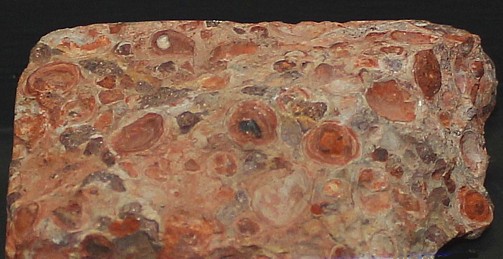|
.
Bauxite
Mineral Facts:
Chemical
Formula: Al2O(OH)4
Pisolitic
or earthy and granular rock which is essentially a mixture of hydrated
aluminum oxides, generally with impurities.
Colors:
Dirty-white when pure, but
usually found as yellow, gray, red or brown in color.
Hardness:
ranges 1 to 3
Hardness
depends much on impurities and porosity of the rock.
Density:
2.2 to 2.55
Cleavage:
None - this aluminum ore is a rock.
Crystallography: None (rock)
Foun in round pisolitic
or oolitic
concretionary grains; also massive, earthy, claylike.
Luster:.
Dull to earthy luster.
|
 |
|
Composition, Structure and
Associated Minerals:
Bauxite, once
considered as a hydrated aluminum oxide mineral, is actually a mixture of
minerals, which technically makes it a rock. It consists mostly of the
minerals gibbsite Al(OH)3, boehmite AlO(OH), and diaspore AlO(OH),
together with the two iron oxides goethite and hematite, as well as the clay
mineral kaolinite. Because of this, it is unknown in individual crystals. It
is of considerable importance as the principal source of the aluminum ore on
the market. It is a secondary material derived from the decomposition of
rocks containing aluminum silicates. Sometimes as a residual deposit,
preserving evidences of the original rock structure; sometimes oolitic and
concretionary in character and evidently deposited from water. It may,
perhaps, at times, be deposited by waters from hot springs.
Lateritic bauxites (silicate
bauxites) are distinguished from karst bauxite ores (carbonate bauxites).
Karst derived bauxite occurs at the type location near Baux, France, in
disseminated grains in limestone in a pistolitic form with some
calcite
as cement. Laterite derived bauxites as are found in above silicate rocks
rich in aluminum. In this way it is found in Arkansas, it is a residual
weathering product of an igneous rock, syenite. It occurs in beds associated
with
corundum, clay, gibbsite and other aluminum minerals.
Identification
and Diagnostics
Infusible. Insoluble. Assumes a
blue color when its powder is moistened with cobalt nitrate and then ignited
(test for aluminium). Gives water in closed tube.
The mineral is with difficulty soluble in hydrochloric acid.
Localities
The principal source of supply for
bauxite is Australia. Other
large producers are China, Brazil, Guinea, and
India. The original type
locality is at Baux, near Aries, France.
It has also been found near
Lake Wochein, in Slovenia;
in Nassau; and at Antrim, in Ireland. In
the United States the chief deposits are found in Georgia, Alabama and
Arkansas. Specifically
in a stretch of country between
Jacksonville, Fla., and Cartersville,
Ga.; in Saline and Pulaski Counties, Ark.; in Wilkinson Co., Ga., and near
Chattanooga, Tenn.
Industrial Uses of
Bauxite
This aluminum ore is typically mined in
surface pits then crushed and washed. It is then, in some cases, dried and
broken into fine particles. The fine dust heated in a pressure vessel along
with a sodium hydroxide solution at a temperature of 150 to 200 °C (the
Bayer process). At these temperatures, the aluminum is dissolved into the
solution as an aluminate. After filtering out the ferruginous residue, pure
gibbsite is precipitated once the liquid is cooled, and seeded with
fine-grained aluminum hydroxide. The final product is a fairly pure aluminum
oxide. Bauxite (or more properly the mixture of diaspore, bohemite and
gibbsite) is practically the only commercial ore of aluminum which, on
account of its lightness and its freedom from tarnish on exposure, has
become a very popular metal for use in many products as well as
construction. It is employed in castings where light weight is desired and
in the manufacture of ornaments and of plates for interior metallic
decorations. It is also employed in the steel industry, and, in the form of
wire, for the transmission of electricity. The mineral is also used in the
manufacture of aluminum salts, in making artificial corundum abrasives, and
bauxite brick for lining furnaces, and in the manufacture of paints and
alloys.
.Return
to the
Mineral Collectors Information Page |
|


